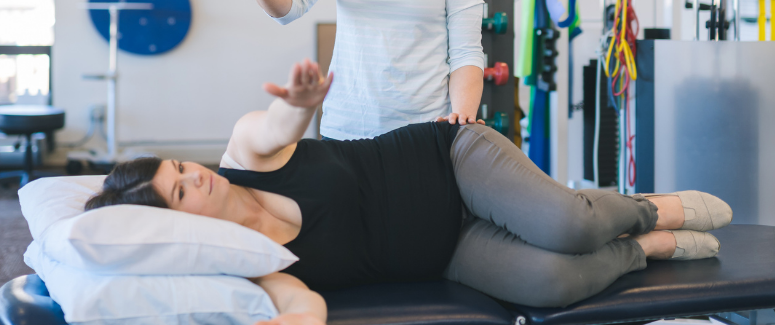by Gabe Battaglia, SPT
Physical Therapy For Pregnancy Related Conditions
Numerous physiological changes occur during pregnancy to allow for development of the fetus. Endocrine, cardiovascular, respiratory, and musculoskeletal changes increase the risk of:
- hypoxia (inadequate supply of oxygen in tissues)
- orthostatic hypotension (sudden drop in blood pressure when standing up)
- hyperventilation
- heart palpitations
- dyspnea (difficulty breathing)
- lower chest compliance (decreased ability for the cheat to expand during inhalation)
These effects lead to an overall decrease in exercise tolerance. These physiological changes can also cause certain pregnancy-related conditions.
Three common conditions include:
- Lumbopelvic pain
- Diastasis recti abdominis
- Carpal tunnel syndrome
Lumbopelvic Pain
Lumbopelvic pain (pain in the low back, pelvis, or both) occurs in over 50% of pregnant individuals. Poor posture commonly causes or contributes to this condition. The increased abdominal weight and postural changes adds pressure on the back and pelvis, leading to pain in these areas. Common treatment techniques include:
- Core strengthening
- Pelvic floor strengthening
- Pelvic belts
- Manual therapy (soft tissue mobilization, myofascial release)
- Modalities (heat, TENS)
Lumbopelvic pain can greatly limit activity tolerance and lead to sedentary behavior. Pelvic belts can be used as an external stabilizer and decrease lumbopelvic pain enough to engage in activity, such as going for walks or doing core strengthening exercises. Strengthening the core and pelvic floor improves internal stability and decrease lumbopelvic pain.
Diastasis Recti Abdominis (DRA)
Diastasis recti abdominis (DRA) occurs when the left and right rectus abdominus muscles separate. This occurs in about 60% of pregnant individuals. Lumbopelvic pain, poor posture, pelvic floor dysfunction, urinary incontinence, and muscle weakness are common symptoms of DRA. Common treatment techniques include:
- Core strengthening
- Diaphragmatic breathing
- Manual therapy
The most effective way to prevent DRA is to exercise prenatally. Strengthening the abdominal muscles, especially the transverse abdominus, and improving the integrity of the linea alba (connective tissue connecting the right and left rectus abdominus muscles), decreases the likelihood and degree of DRA.
Carpal Tunnel Syndrome
Carpal tunnel syndrome occurs when the median nerve is compressed within an area of the wrist called the carpal tunnel. This leads to pain, tingling, and numbness of the thumb, index finger, middle finger, and half of the ring finger. Pregnancy-related carpal tunnel syndrome often resolves postpartum. Management techniques include:
- Activity modification (proper ergonomics, avoiding excessive vibration)
- Splinting
- Nerve glides
- Improving dexterity and grip strength
- Soft tissue and carpal bone mobilization
For information on physical therapy during pregnancy and how it can help in managing pregnancy-related conditions, contact Capital Area Physical Therapy at 518-289-5242 to set up an appointment with one of our physical therapists. CAPT has PT clinics in Malta, Saratoga, or Queensbury.






